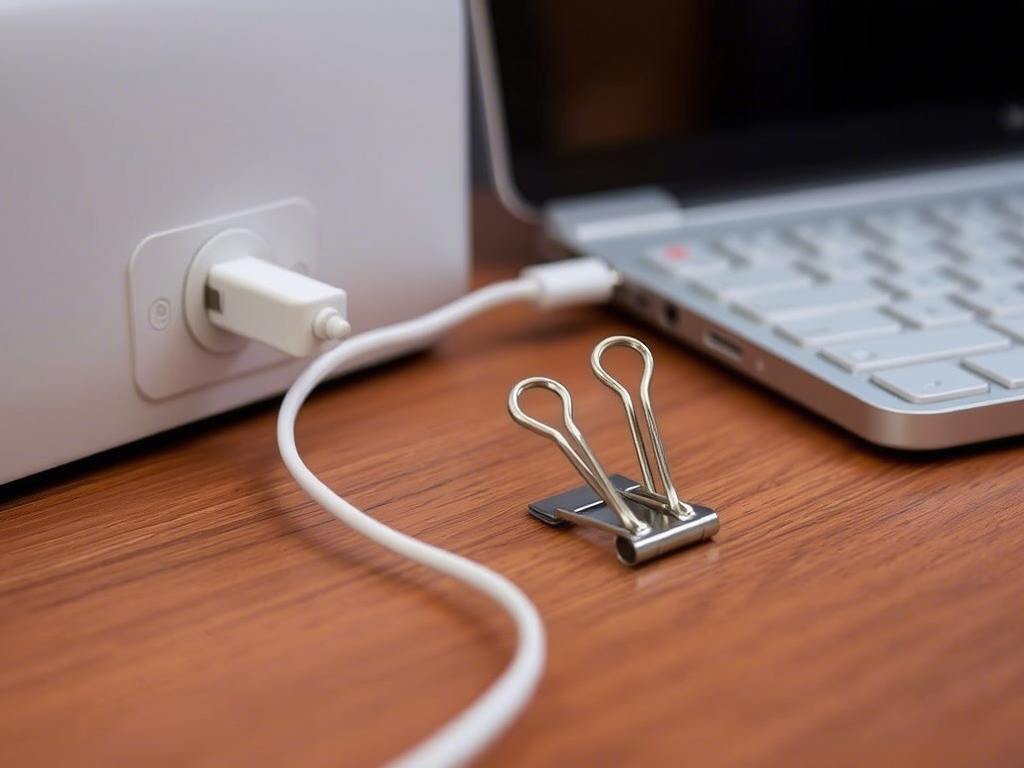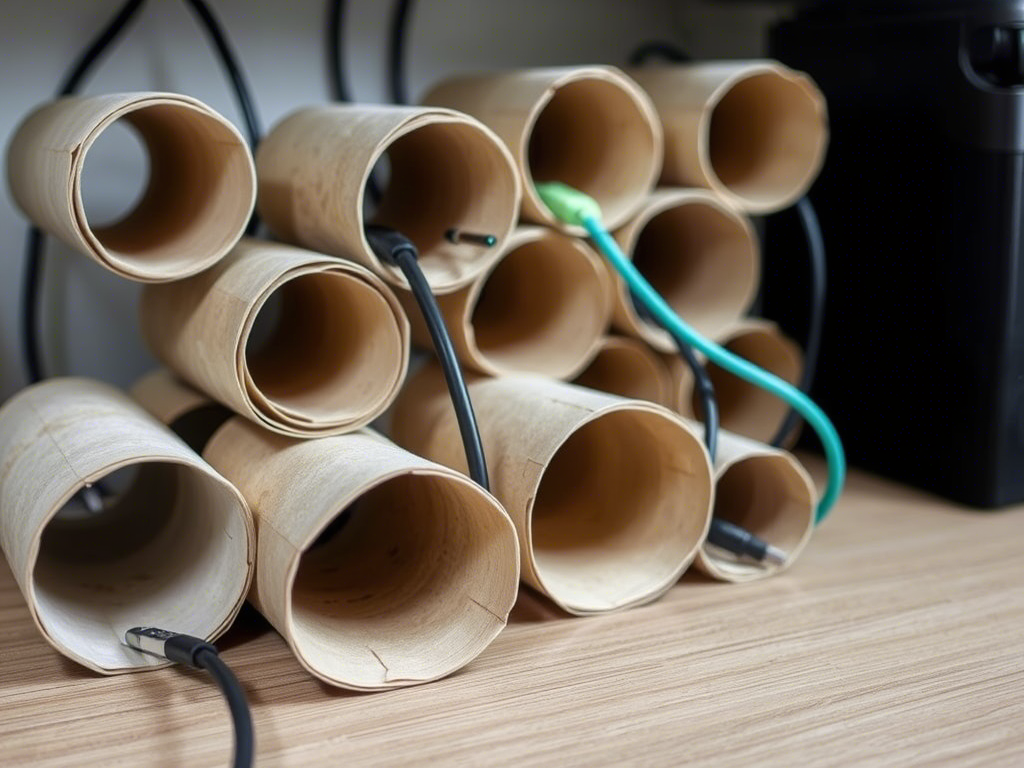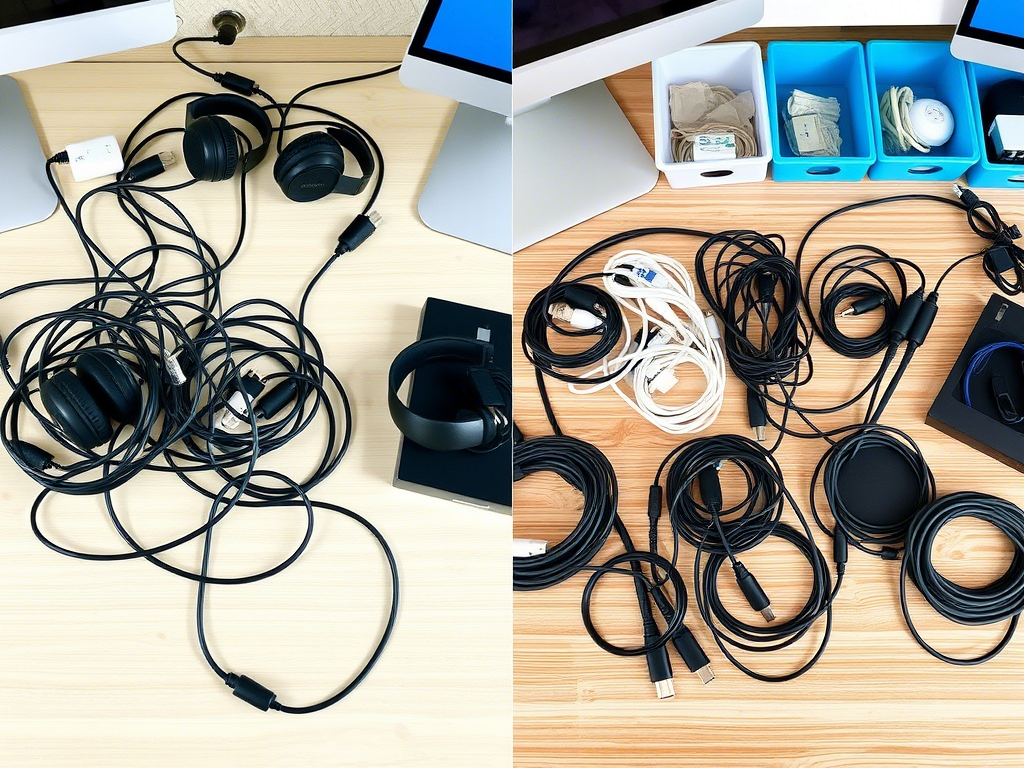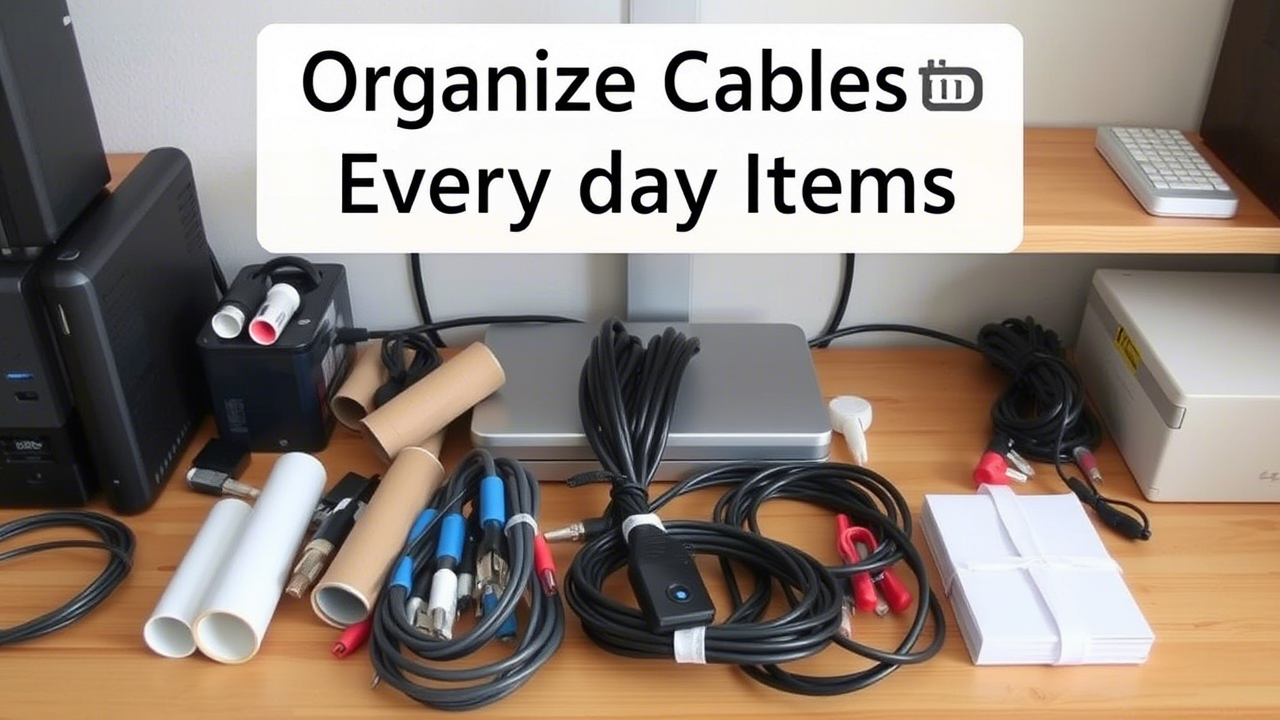Do you ever find yourself frustrated by tangled, messy cables? It’s something we all deal with—whether it’s the jumble of charging cords, tangled headphones, or those never-ending wires behind your desk.
I used to dread pulling out my laptop charger because I knew I’d spend a few minutes untangling it first. Over time, it became clear that my cables needed a better system.
That’s when I decided to look for simple ways to organize cables using things I already had at home.
I was amazed by how easy it was to keep everything neat and accessible without spending a penny.
With just a few everyday items like binder clips, shoe boxes, and Velcro straps, I transformed my workspace into a clutter-free zone.
In this post, I’ll share some of my favorite DIY tricks for managing cords and cables—whether you have a few or a whole drawer full.
Get ready to say goodbye to tangled messes and hello to an organized, stress-free space.
Key Takeaways
- Everyday items like binder clips and toilet paper rolls can keep cables organized.
- DIY solutions are cost-effective and easy to set up.
- Simple tricks can keep your workspace neat and tangle-free cables.
- Organized cables make it easier to find and use your electronics.
Now, let’s start with one of my favorite hacks—binder clips!
1. Binder Clips

Binder clips are lifesavers. I first discovered their usefulness when I got tired of my phone charger constantly falling behind my desk.
Every time I unplugged it, it slipped off the edge, forcing me to crawl under the desk to retrieve it. Sound familiar? A simple binder clip fixed the problem instantly.
How to Use Binder Clips for Cable Management
- Attach a binder clip to the edge of your desk.
- Thread your cable through the metal loop of the clip.
- Pull the cable through until it’s snug but still easy to move.
Now, your charger or cord organizer stays in place, ready to use when needed. No more bending under the desk!
Other Ways to Use Binder Clips for Cables
- Use multiple clips to separate different types of cables.
- Label the handles of the clips with a marker for easy identification.
- Clip them to a power strip to prevent cables from getting tangled.
Binder clips are cheap, easy to find, and incredibly effective. They’ve saved me so much frustration, and I always keep a few on hand.
2. Toilet Paper Rolls

I used to throw away empty toilet paper rolls without a second thought. But one day, I saw a tip online about using them for cable management, and it changed everything. Now, I never waste them—they’ve become one of my favorite DIY cord organizer solutions!
How to Use Toilet Paper Rolls for Cable Storage
- Take an empty toilet paper roll.
- Fold or coil your cables neatly.
- Slide them inside the roll to keep them from tangling.
- Label the roll with a marker to identify the cable inside.
This trick works especially well for storing extra chargers, headphones, and USB cables. I keep a small box filled with labeled rolls so I can find the right cable instantly. No more digging through a messy drawer!
Creative Ways to Customize Toilet Paper Rolls
- Decorate them with wrapping paper or washi tape for a neater look.
- Use paper towel rolls for longer cables.
- Punch holes in the sides to create a DIY charging station.
Toilet paper rolls are free, effective, and surprisingly durable. If you need a simple way to keep your cables tangle-free, this is one of the easiest solutions.
3. Zip Ties
Zip ties are a game-changer. They are perfect for bundling up cables and making your workspace or entertainment setup look neat and tidy. However, it’s important to use them correctly to avoid potential issues.
I first used them when setting up my home office, and they’ve helped me keep everything organized. But there are a few things you need to keep in mind when using zip ties.
How to Use Zip Ties for Cable Organization
- Gather cables that run in the same direction.
- Wrap a zip tie around them and tighten it just enough to hold them together.
- Trim off the excess tie for a neat look.
This method is great for keeping cables organized behind your desk, TV, or home entertainment center. I use zip ties for power cords, HDMI cables, and extension cords. It prevents everything from becoming a tangled mess.
Emphasizing Safety
While zip ties are great for cable management, be cautious not to overtighten them. If you pull too tightly, it can damage the cables, especially if you’re working with data cables like Ethernet or HDMI.
Always check the integrity of the cable after using zip ties to ensure it hasn’t been compromised.
Reusable Zip Ties
While some reusable zip ties are available, they are less common. If you need to adjust or remove your cable bundles frequently, consider using Velcro straps instead. They offer a much easier way to reconfigure your cable setup without causing any damage.
4. Bread Bag Tags
I was skeptical at first when I heard about using bread bag tags to organize cables, but after trying it, I was amazed. It’s such a simple and cost-free way to keep your cords labeled and accessible.
How to Use Bread Bag Tags for Cable Management
- Collect bread bag tags from loaves of bread.
- Write the name of each device on a tag with a permanent marker.
- Clip the tag onto the cord near the plug.
This is a simple yet effective way to ensure you don’t waste time trying to figure out which cable belongs to which device. I use this method for my phone charger, printer, and external hard drive cables.
For Increased Durability
For increased durability, reinforce bread bag tags with clear tape. This will help them last longer, especially if you plan to use them for a significant period.
If you’re dealing with cables that will be moved around often, consider using a sturdier labeling method, like adhesive labels or small tags with stronger materials.
👉Check Now Best Bread Bag Tags🫨
5. Shoe Boxes
Shoe boxes are a classic go-to solution for cable management, and they’ve been a lifesaver for me.
I used to have a drawer full of tangled cords, but now, each type of cable has its designated space.
How to Use Shoe Boxes for Cable Storage
- Find an empty shoe box.
- Cut small holes on one side for cables to pass through.
- Label each hole for different types of cables.
- Coil the cables neatly inside and pull the ends through the holes.
Shoe boxes help keep your cables organized and out of sight. I use them to store extra chargers, HDMI cables, and USB cords.
The boxes help prevent clutter, and the labeled holes make it easy to grab the right cable when I need it.
Ensuring Ventilation
If you’re storing charging devices or electronics in your shoe boxes, ensure adequate ventilation to prevent heat buildup.
Consider adding extra ventilation holes or leaving the box slightly open if you’re storing something that generates heat.
This is especially important for devices that are plugged in for long periods.
6. Command Hooks
Command hooks are one of the easiest and most versatile solutions for cable management. They help you keep cables off the floor and neatly organized along walls or furniture.
I first used them when I was trying to organize cables behind my desk, and it worked wonders.
How to Use Command Hooks for Cable Organization
- Choose small or medium-sized command hooks.
- Stick them along the edge of your desk, wall, or behind furniture.
- Run your cables through the hooks to keep them neatly in place.
This method helps cables stay within easy reach without falling all over the place. I now use it to keep my charger cables, headphones, and even my laptop power cord organized and accessible.
Important Considerations for Command Hooks
- Weight Limit: Be mindful of the weight of the cables you’re hanging. Command hooks have weight limits, and overloading them can cause them to fall. It’s best to keep your cables light and prevent them from becoming too heavy for the hook.
- Surface Compatibility: Some command hook adhesives can damage certain surfaces. Always test the adhesive on an inconspicuous area before sticking them onto your wall or furniture. This helps ensure that you won’t damage the paint or finish.
Command hooks are an excellent option for those who want a simple and non-permanent cord organizer. They’re easy to install and take down without leaving any damage behind.
7. Velcro Straps
I used to rely on rubber bands to bundle my cables, but they snapped over time and became a hassle.
Then I switched to Velcro straps, and I’ve never looked back. They are reusable, adjustable, and ideal for keeping cords neatly bundled.
How to Use Velcro Straps for Cable Management
- Gather the cables you want to bundle.
- Wrap a Velcro strap around them and secure it.
- Adjust as needed whenever you add or remove a cable.
I use Velcro straps for everything—bundling laptop chargers, wrapping up extension cords, and keeping extra cables neatly stored.
Unlike zip ties, they don’t need to be cut off, so they’re perfect for cables you use frequently.
Tips for Using Velcro Straps Effectively
- Buy different colors to organize cables by category.
- Use them for travel to keep chargers and earphones neat.
- Attach them to power cords so you can wrap excess length when needed.
Velcro straps make cable management easy and hassle-free. If you want a simple, reusable solution, this is one of the best options out there.
👉Check Now Best Velcro straps🫨
General Cable Health and Maintenance
While DIY solutions for cable management are great, it’s essential to remember the health of your cables.
Regularly check your cables for damage, like frays, cuts, or exposed wires, as these can lead to unsafe situations or poor performance.
If you notice any damage, it’s a good idea to replace the cable to ensure everything continues to work properly.
Cable Organizers
While DIY solutions are fantastic, there are commercially available cable organizers like cable trays, clips, and sleeves that can make your life even easier.
These options offer a more polished and sometimes more durable solution. However, they come with a price.
If you’re willing to spend a little more, they provide a neat and aesthetically pleasing look.
Pros:
- Professionally designed for cable management
- Often more durable and long-lasting
- Can be aesthetically pleasing
Cons:
- Higher cost
- May not offer as much flexibility as DIY solutions
If you need accessories to make Cable Organizers, then you can buy from here at affordable prices 👉 Cable Organizers accessories
Cable Coiling Best Practices
When bundling cables, avoid tightly coiling them, especially those with delicate internal wiring.
Tightly wound cables can be damaged over time, causing them to fray or break. Instead, create larger loops or use a figure-eight wrap to maintain their integrity while still keeping them neat.
Disposing of Old Cables
Old or broken cables should be disposed of properly. Many electronics retailers and local recycling programs offer e-waste collection events.
Recycling your cables ensures that the materials are reused in an eco-friendly way and helps reduce environmental waste.

FAQs About Organize Cables
1. What is the best way to keep cables from tangling?
The best way to keep cables tangle-free is by using simple DIY solutions like binder clips, Velcro straps, or toilet paper rolls. Storing cables neatly and using labels also helps prevent messes.
2. How can I organize cables without buying expensive organizers?
You can use everyday household items like shoe boxes, command hooks, and bread bag tags for cable management. These items are free or very cheap and work just as well as store-bought solutions.
3. How do I prevent my charging cables from falling behind my desk?
Binder clips and command hooks are great for keeping chargers in place. Attach them to the edge of your desk and loop your cable through to keep it easily accessible.
4. What is the easiest way to store extra cables?
Use a shoe box with labeled compartments or toilet paper rolls to keep cables organized and easy to find. This prevents clutter and makes it simple to grab the right cable when needed.
5. Are zip ties better than Velcro straps for cable management?
Zip ties are great for permanent cable bundling, while Velcro straps are better for cables you need to adjust frequently. If you want a flexible solution, Velcro straps are the better choice.
6. Is it bad to coil cables tightly?
Yes, tightly coiling cables, especially those with internal wiring, can damage them. Create larger loops or figure-eight wraps instead.
Final Thoughts
Organizing cables doesn’t have to be a complicated or expensive task. With a few simple DIY solutions, you can easily organize cables and transform your space from chaotic to neat.
From binder clips to shoe boxes, using everyday items can save you time, money, and stress.
After trying these solutions myself, I can confidently say that they work wonders. No more tangled messes or frustration with finding the right charger.
By focusing on organizing my cables, I’ve created a cleaner, more efficient workspace. It feels great to have everything neatly stored and easily accessible.
Remember, whether you’re using Velcro straps or simple bread bag tags, taking the time to organize your cables can make a huge difference. So, give these tips a try and experience the freedom of a clutter-free environment.
Have you tried any of these methods? Or do you have your own unique way to organize cables? I’d love to hear about it!




